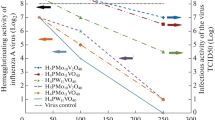Summary
Soluble components of adenovirus types 1, 2, 5 and 6 were separated by anion exchange chromatography. Four different components eluting in the following sequence were demonstrated: Incomplete hemagglutinin (HA), identifiable only in the presence of antisera against members ofRosen's subgroup III (i.e. fibers), early and late eluting complete HA, only the latter of which was markedly enhanced in the presence of anti-sera against members of any ofRosen's three subgroups (i.e. pentons), and group-specific complement-fixing (CF) antigen (i.e. hexons).
In preparations of serotypes 5 and 6 the major part of the complete HA was of the late-eluting, penton-associated form, whereas the complete HA of types 1 and 2 mainly were early eluting. Pentons prepared by anion exchange chromatography were fractionated by zonal centrifugation in sucrose gradients or exclusion chromatography. Two populations of pentons were distinguishable. The one with the larger mass carried complete HA activity the titer of which was increased in the presence of heterotypic antisera against members of all ofRosen's, subgroups. The other population of pentons could only function as an incomplete HA, identifiable by group-specific hemagglutination enhancement. Toxin activity was carried by both populations of pentons.
Trypsin treatment destroyed the toxin activity and eliminated the HA activity, complete or incomplete, of both populations of pentons. Incubation of isolated complete penton HA at 56° C resulted in a dissociation into incomplete penton and fiber HA.
It is assumed that the incomplete penton HA represents isolated pentons, whereas an aggregation of two to four pentons into a polyvalent complex is as prerequisite for a complete HA activity. This assumption is supported for adenovirus type 6 by electronmicroscopy.
Similar content being viewed by others
References
Everett, S. F., andH. S. Ginsberg: A toxinlike material separable from type 5 adenovirus particles. Virology6, 770 (1958).
Gelderblom, H., H. Bauer, H. Frank, andR. Wigand: The structure of group II adenoviruses. J. gen. Virol.1, 553 (1967).
Gelderblom, H., R. Wigand, andH. Bauer: DEAE-chromatography of adeno-viruses of Rosen's group II. Nature (Lond.)205, 625 (1965).
Ginsberg, H. S., andJ. H. Dingle: The adenovirus group. In:F. L. Horsfall andI. Tamm, Viral and Rickettsial Infections of Man. 4th ed., Philadelphia, Pa., J. B.Lippincott Co., (1965).
Ginsberg, H. S., H. G. Pereira, R. C. Valentine, andW. C. Wilcox: A proposed terminology for the adenovirus antigens and virion morphological subunits. Virology28, 782 (1966).
Haruna, I., H. Yaoi, R. Kono, andI. Watanabe: Separation of adenovirus by chromatography on DEAE-cellulose. Virology13, 264 (1961).
Kasel, J. A., andM. Huber: Relationship of the adenovirus erythrocyte-receptor-modifying factor to the type-specific complement fixing antigen. Proc. Soc. exp. Biol. (N.Y.)116, 16 (1964).
Kjellén, L.: A study of adenovirus-host cell system by the plaque technique. Virology14, 234 (1961).
Klemperer, H. G., andH. G. Pereira: Study of adenovirus antigens fractionated by chromatography on DEAE-cellulose. Virology9, 536 (1959).
Martin, R. G., andB. N. Ames: A method for determining the sedimentation behaviour of enzymes: application to protein mixtures. J. biol. Chem.236, 1372 (1961).
Miller, F., andH. Metzger: Characterization of a human macroglobulin. I. The molecular weight of its subunit. J. biol. Chem.240, 3325 (1965).
Norrby, E.: The relationship between the soluble antigens and the virion of adenovirus type 3. I. Morphological characteristics. Virology28, 236 (1966a).
Norrby, E.: The relationship between the soluble antigens and the virion of adenovirus type 3. II. Identification and characterization of an incomplete hemagglutinin. Virology30, 608 (1966b).
Norrby, E.: Identification of soluble components of adenovirus type 11. J. gen. Virol.2, 123 (1968a).
Norrby, E.: Comparison of soluble components of adenovirus types 3 and 11. J. gen. Virol.2, 135 (1968b).
Norrby, E., B. Nygren, P. Skaaret, andA. Lengyel: Separation and characterization of soluble adenovirus type 9 components. J. Virol.1, 1101 (1967).
Norrby, E., andG. Wadell: Soluble components of adenovirus type 4. Virology31, 592 (1967).
Pereira, H. G.: A protein factor responsible for early cytopathic effect of adenoviruses. Virology6, 601 (1958).
Pereira, H. G., andM. V. T. de Figueiredo: Mechanism of hemagglutination by adenovirus types 1, 2, 4, 5 and 6. Virology18, 1 (1962).
Petterson, U., L. Philipson, andS. Höglund: Structural proteins of adeno-viruses. I. Purification and characterization of adenovirus type 2 hexonantigen. Virology33, 575 (1967).
Philipson, L.: Separation on DEAE-cellulose of components associated with adenovirus reproduction. Virology10, 459 (1960).
Robbins, J. B., K. Kenny, andE. Suter: The isolation and biological activities of rabbit γM- and γG-anti-salmonella typhimurium antibodies. J. exp. Med.122, 385 (1965).
Rosen, L.: A hemagglutination-inhibition technique for typing adenoviruses. Amer. J. Hyg.71, 120 (1960).
Rowe, W. P., J. W. Hartley, B. Roizman, andH. B. Levy: Characterization of a factor formed in the course of adenovirus infection of tissue culture causing detachment of cells from glass. J. exp. Med.108, 713 (1958).
Sever, J. L.: Application of a microtechnique to viral serological investigations. J. Immunol.88, 320 (1962).
Valentine, R. C., andH. G. Pereira: Antigens and structure of the adenovirus. J. molec. Biol.13, 13 (1965).
Wadell, G., E. Norrby, andU. Schönning: Ultrastructure of soluble antigens and the virion of adenovirus type 4. Arch. ges. Virusforsch.21, 234 (1967).
Wadell, G., andP. Skaaret: Separation of adenovirus type 4 components. Arch. ges. Virusforsch.21, 366 (1967).
Wilcox, W. C., andH. S. Ginsberg: Purification and immunological characterization of types 4 and 5 adenovirus-soluble antigens. Proc. nat. Acad. Sci. (Wash.)47, 512 (1961).
Wilcox, W. C., H. S. Ginsberg, andT. F. Anderson: Structure of type 5 adenovirus II. Fine structure of virus subunits. Morphologic relationship of structural subunits of virus-specific soluble antigens from infected cells. J. exp. Med.118, 307 (1963).
Author information
Authors and Affiliations
Additional information
Supported by grants from the Swedish Medical Research Council (Project no. K67-16x-548-03 and B68-16x-744-03C).
Rights and permissions
About this article
Cite this article
Wadell, G., Norrby, E. & Skaaret, P. The soluble hemagglutinins of adenoviruses belonging to Rosen's subgroup III. Archiv f Virusforschung 26, 33–52 (1969). https://doi.org/10.1007/BF01241174
Received:
Issue Date:
DOI: https://doi.org/10.1007/BF01241174




